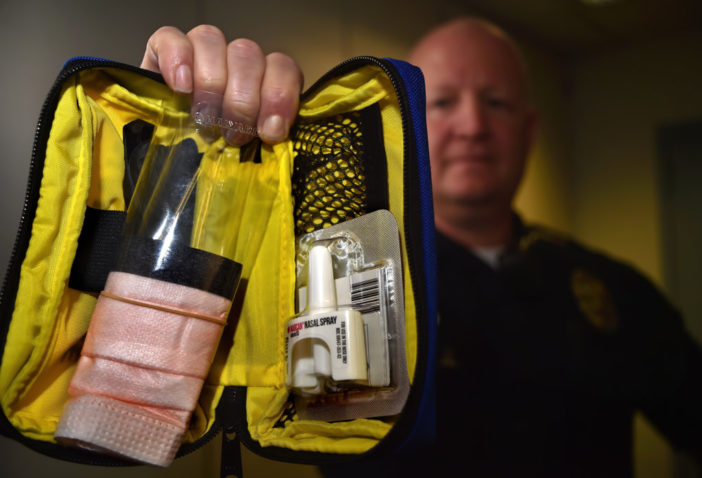La Habra police officers on Dec. 12 saved a man’s life using a drug recently added to the PD’s arsenal — a nasal spray that prevents opioid overdoses.
The officers received a call of a man down at the Super Store at 500 W. Lambert Road in La Habra at 8:49 p.m.
When they arrived, the man who made the call told officers his friend had injected heroin.
Officer Muris Lucarevic retrieved the blue-and-yellow pouch given to La Habra PD officers, and administered the Narcan Naloxone 4-milligram spray to the 22-year-old overdose victim, who had several prior arrests that included drug-related arrests.

La Habra PD trains and equips officers with Naloxone Opioid Overdose Kits, the nasal spray version, (Narcan™) for on-the-spot treatment, before paramedics can arrive, of suspected opioid overdoses.
File photo by Steven Georges/Behind the Badge OC
“The department issued us these because we’re seeing more and more overdoses,” Lucarevic said. “This is not the first time I’ve come across somebody who overdosed.”
Shortly after giving the Naloxone, the victim began breathing and regained consciousness. Lucarevic stayed at the scene until Los Angeles County Fire Paramedics arrived and took the man to St. Jude Medical Center in Fullerton.
“You can’t see this every day, when people go from not breathing and no pulse to coming back to life,” Lucarevic said.
All La Habra police officers trained this past summer on administering Naloxone, which blocks and reverses the effects of opioids (including heroin, methadone, morphine, opium, codeine, fentanyl, oxycodone, and hydrocodone). The drug takes one to three minutes to work, and lasts 30 to 90 minutes. Since the program’s implementation, La Habra officers have had four successful saves with the Naloxone/Narcan, of the six applications.
“It’s pretty easy to use and it is effective,” Lucarevic said.
La Habra is the latest in a growing number of law enforcement agencies to train officers and stock the life-saving drug. The officers can also use the nasal spray if they are exposed to an opioid in powder form.
Officers check out one of 16 kits (containing two doses, gloves, and a mask) at the station when they start their patrol shift. The kits cannot be kept in the car all the time because the medication is sensitive to extreme heat and cold, and the department has enough to cover the eight to 10 officers working each patrol shift.
Signs of an opioid overdose can include deep snoring (labored breathing), shallow or slow breathing (less than eight breaths per minute), not breathing at all, pale and moist skin, slow and weak pulse, and no response to verbal or touch stimulation.
“In some situations, individuals are high on something else and you can’t administer the Narcan,” Lucarevic said. “A person using cocaine, or meth, or something else, could exhibit different symptoms such as high pulse, agitation, rigid muscles, and hallucinations. In those cases, Narcan is not an option.”
La Habra PD asks that anyone who witnesses a person experiencing an overdose immediately dial 911. California law provides protection from prosecution of drug possession for persons reporting drug-related overdoses.
 Behind the Badge
Behind the Badge



